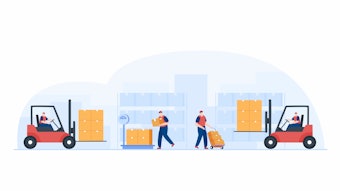
Twenty years ago, Supply and Demand Chain Executive (SDCE) magazine first launched, and along with it, a variety of content and news that may now seem like a different world to today’s readers.
In September 2000, SDCE, then named iSource Business, published an article titled, “Hey Bidder, Bidder… It’s an Online Auction,” which detailed the exciting new trend in auctions when they began to take place online. The most blatant comparison from the original article to today is that auctions and reverse auctions now primarily take place in digital settings, like many other tasks in today’s modern world. It is no longer a new aspect to the industry or even a question if a company would feel comfortable taking its auctions online.
Online marketplaces and auctions first became popular for physical goods and have now flourished in the B2B sector, where companies go for a variety of factors such as selling excess and returned products, as well as finding suppliers and other partners.
“It’s interesting to see this story from 20 years ago and remember the high hopes placed in electronic marketplaces,” says Paul Shagawat, co-founder and managing partner at Transparent Energy, which provides software and data for companies to find the best partner for their energy needs. “These early examples focus on the buying and selling of physical goods and services. At Transparent Energy, we built on these early models to bring together business buyers of energy – namely electricity, natural gas, and later, renewables – with energy suppliers over the Internet, replacing inefficient, opaque paper-based sourcing processes with a transparent one that occurred in real time.”
Another example in the B2B auction sector is SteelSalvor, a platform for companies to find steel suppliers and vice versa. Now, there are numerous online platforms similar to this in all sectors of the supply chain, making auctions and reverse auctions to be a standard digital practice. Twenty years ago, the supply was just beginning to experience the shift.
The original article states that “by 2002, 93% of firms expect some of their business trade to flow over the Internet, and a quarter of firms anticipate that most of their online trade will flow through e-marketplaces. e-marketplaces include auctions, aggregators, bid systems and exchanges,” according to a February 2000 Forrester Research study. Today, all or most of the bidding process takes place online.
“Leveraging auctions to sell and buy inventory has grown significantly in the last two decades; this is particularly true in the B2B space,” says Eric Moriarty, vice president at B-Stock. “For example, nine of the top 10 U.S. retailers are currently using branded, online auction B2B marketplaces - like the ones run by B-Stock - to sell their excess and returned inventory to a large base of business buyers. The auction dynamic, combined with a large buyer base, drives competition enabling higher pricing, a faster sales cycle, and real data on secondary market prices.”
Why digital auctions?
There are significant advantages to these processes now taking place exclusively online.
“For business buyers (aka resellers), B2B auction marketplaces allow for an easier way to access and purchase inventory to resell. The opportunity to source merchandise across all lot sizes, product categories, and price points is fantastic. To put it in perspective: since launching our first B2B auction marketplace in 2009, B-Stock has sold billions of dollars worth of inventory and have experienced a compound annual growth rate of over 100%,” continues Moriarty.
As technology and data grow, these marketplaces, and the sector itself grows along with them. The use of data to target specific buyers who are more likely to be a match is growing and as artificial intelligence becomes more sophisticated, so does the ability to target. Other trends in online bidding are price increases due to heightened competition and new forms of organization.
“When it comes to B2B auction marketplaces for returned and excess goods, many sellers are using data to extract a buyer’s highest willingness to pay. For example, segmenting buyers by product category, condition code, and lot size will match the right buyers with your inventory,” adds Moriarty. “More bidder competition among the right buyers will mean higher prices every time so investing in attracting new buyers is critical. How auction lots are assembled is extremely important, everything from to optimizing price, to segmenting by product type, condition, and original MSRP per item will increase recovery.
“As far as bidding activity goes, we are also seeing increases in apparel transactions. Across our B2B marketplaces that auction apparel, transactions are up 260% over the last three years. This makes sense considering the apparel resale market is growing faster than the primary,” says Moriarty.
Online bidding is now an important part of supply chain operations, much like most of the world. The more technology grows, the more aspects of operations become digitally managed. Companies will be able to tap into data to find the best match in a partner and more. In the next 20 years, B2B marketplaces will see even more innovation.






























